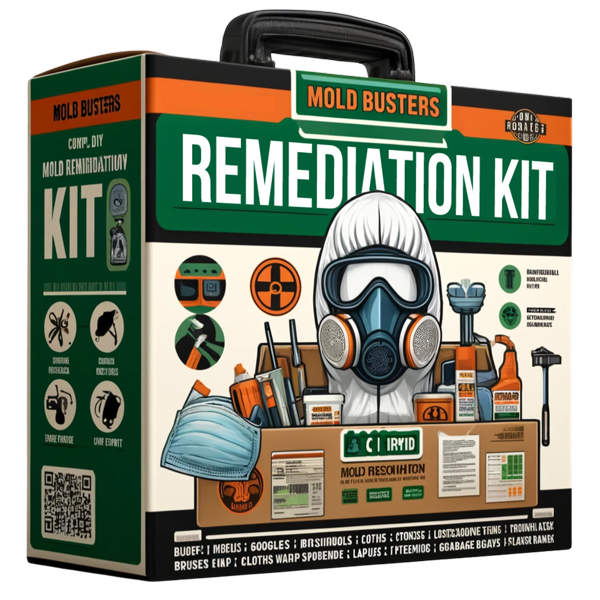White Mold: Is It Dangerous & How to Remove It?
White mold is a lesser-known but still an incredibly dangerous species of mold to deal with. Many people confuse white mold with other types of mold due to its color, making it difficult to detect. This white substance can grow on various building materials, including porous materials, causing potential structural integrity issues.
If you’re ever unsure of what type you have, calling in certified professionals to perform free virtual mold inspection immediately is important. With that said, we’ve learned quite a bit about white mold in our many years of mold inspection and removal. Here’s all you need to know – and more!
Mold is a naturally occurring fungi, much like mushrooms and yeast. Hundreds of species of mold can be found in both indoor and outdoor environments. While many of these species are perfectly safe, others can be hazardous to your health, especially when they grow inside your home.
While most people tend to focus on black mold, also known as Stachybotrys, only a few are concerned about white mold growing within a building or home. However, white mold can also be very dangerous and should be dealt with as soon as possible.
In this article, we will outline the best ways to identify white mold in your home and remove it safely.
Worried About White Mold? Get a Free Inspection!
White mold can be a hidden hazard in your home, difficult to identify and dangerous to your health. Don’t let it go unchecked! Contact Mold Busters for a free virtual mold inspection. Our experts are ready to provide you with a comprehensive assessment and a plan to tackle any mold issue, ensuring your home is safe and healthy. Act now to protect your space!
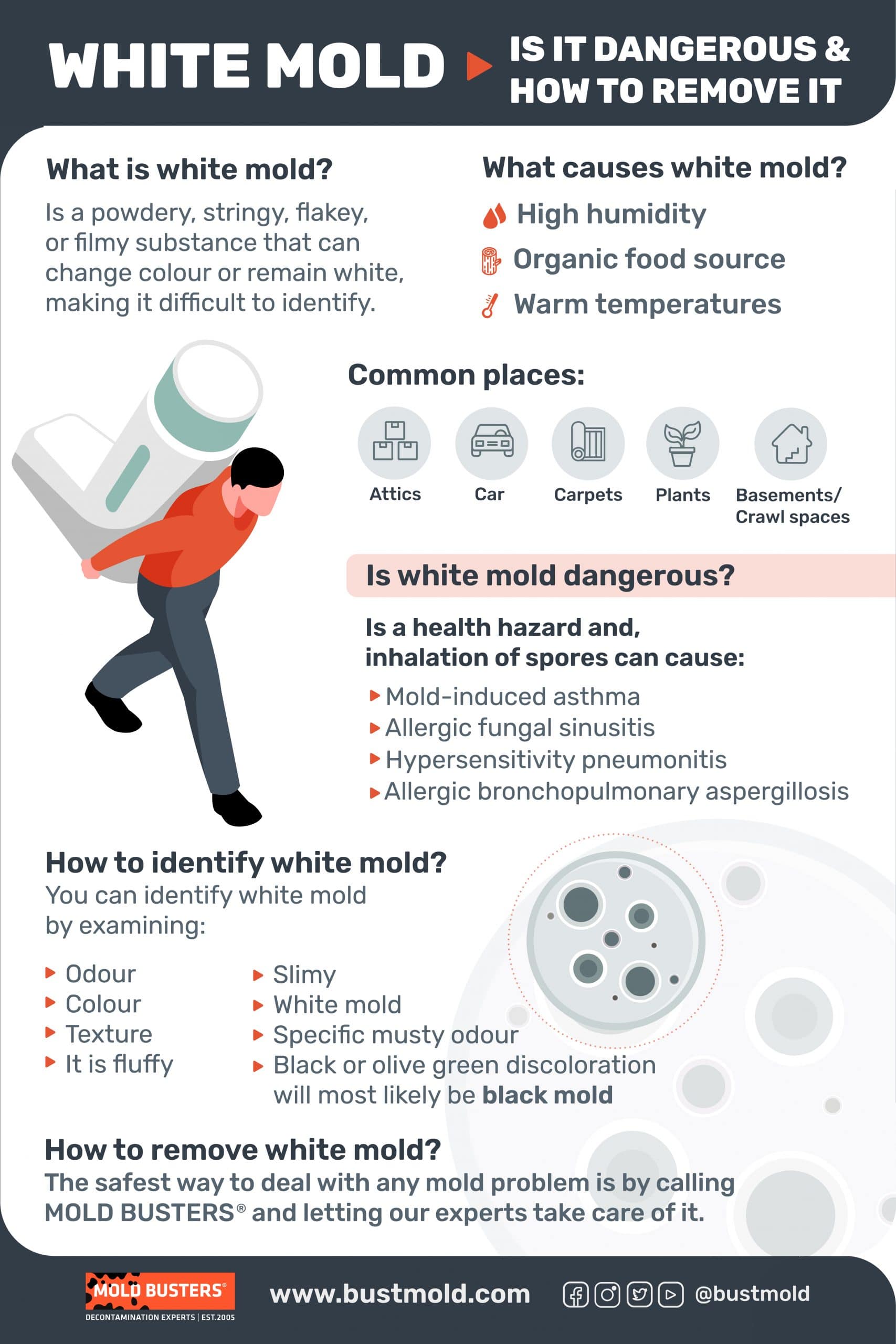
What is white mold?
White mold, often confused with a salt deposit, is a type of fungus that thrives in a moist environment with high humidity. It can grow on a variety of building materials, including hard surfaces like concrete and wood.
Many homeowners don’t realize that they have a white mold problem because of its colour, which makes it difficult to detect. It can grow on plants, fabric, food and other organic materials like drywall, wood and carpeting. This makes it a threat not only to your health, but to the structural safety of your home.
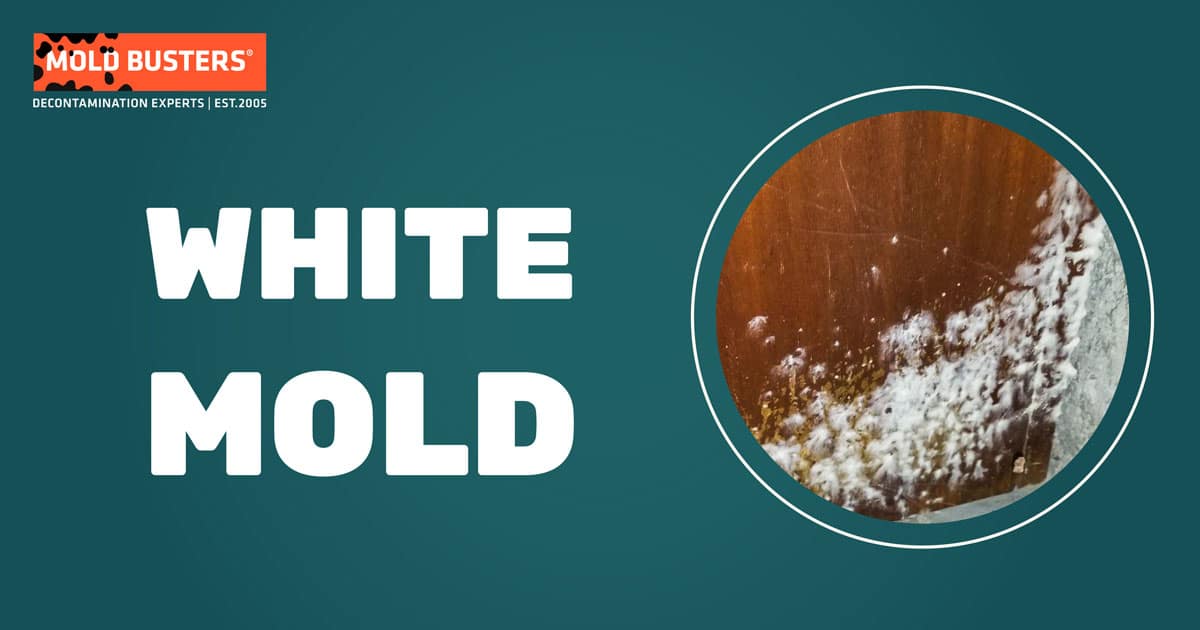
What does white mold look like?
White molds can either remain white or change to green, black, grey, or practically any other colour over time.
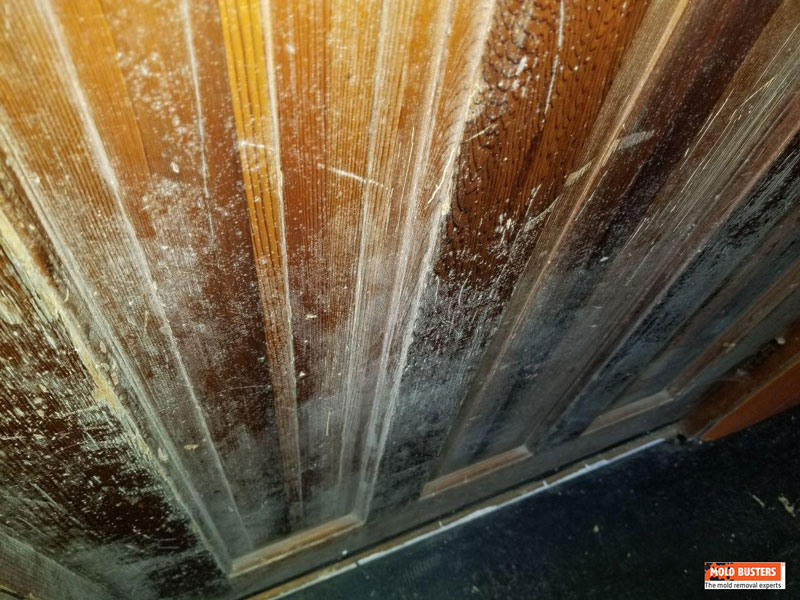
When they first develop, white molds are very hard to detect since the spores are so tiny that they can only be seen under a microscope. Once colonies form, however, white molds appear as spots on a surface. They can be flaky, powdery, stringy or filmy at first glance. They can also resemble mildew, which is the early wwws of mold. However, mildew is relatively harmless when compared to white mold, which can grow not just on surfaces but also deep within organic materials.
White mold growth
White mold growth is a common issue in many homes and buildings, often going unnoticed until it becomes a significant problem. This type of mold thrives in environments with high humidity and excess moisture, making bathrooms, basements, and kitchens prime locations for growth.
White mold can grow on a variety of surfaces, including building materials like wood and drywall, as well as on other organic materials such as clothing and furniture. It’s not uncommon to find white mold growing on hard surfaces in damp areas of your home.
One of the key factors contributing to white mold growth is poor air circulation. Areas that are poorly ventilated can create pockets of stagnant, moist air, which provides an ideal environment for mold growth. This is why you may often find mold in areas like basements and attics, where air circulation can be limited.
Another contributing factor is a persistent moisture problem. This could be due to a leaky pipe, flooding, or simply high humidity levels. In these conditions, white mold can start to appear within 24 to 48 hours.
It’s important to note that white mold doesn’t just grow on the surface of materials. It can penetrate deep into porous materials, which can cause damage to your home and make the mold more difficult to remove.
White mold can also grow in patches, appearing as a light green or white fuzzy substance. Many people confuse white mold with efflorescence, a type of salt deposit that can form on concrete and other building materials. However, unlike efflorescence, white mold can have serious health implications and should be addressed promptly.
If you notice signs of white mold growth in your home, it’s important to address the issue as soon as possible. This includes removing the mold, fixing the moisture problem, and taking steps to prevent future mold growth. In some cases, this may require the help of a mold professional. If you’re in the Montreal or Ottawa area, our team of professionals can help you with this process.
Pictures of white mold
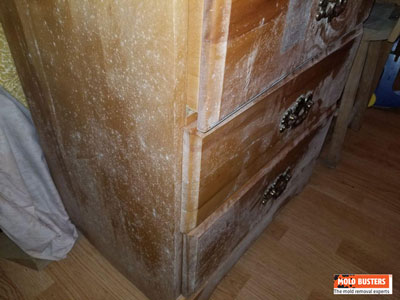
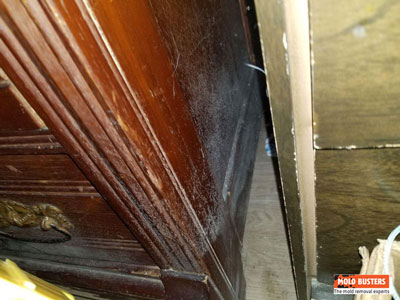
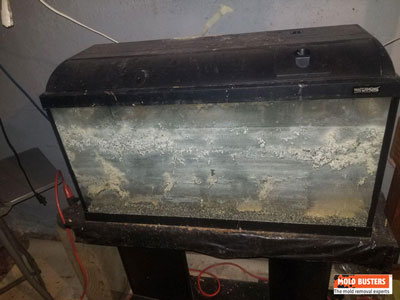
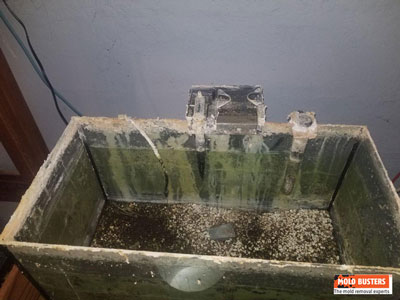
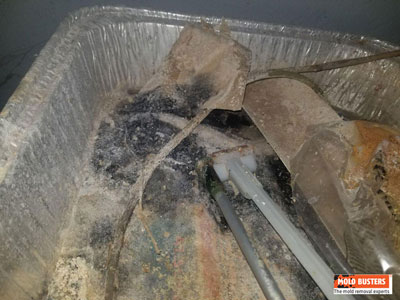
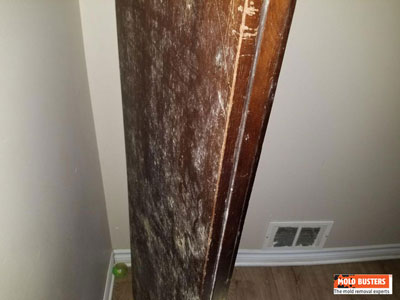
What is the difference between white mold and black mold?
Black mold (Stachybotrys chartarum) is one of the most well known mold species because it’s the most harmful of all the molds found in indoor environments. It is typically greenish-black in colour, which makes it easy to distinguish, especially when found growing in areas of high moisture. Black mold is considered highly toxic mold and poses terrible health risks.
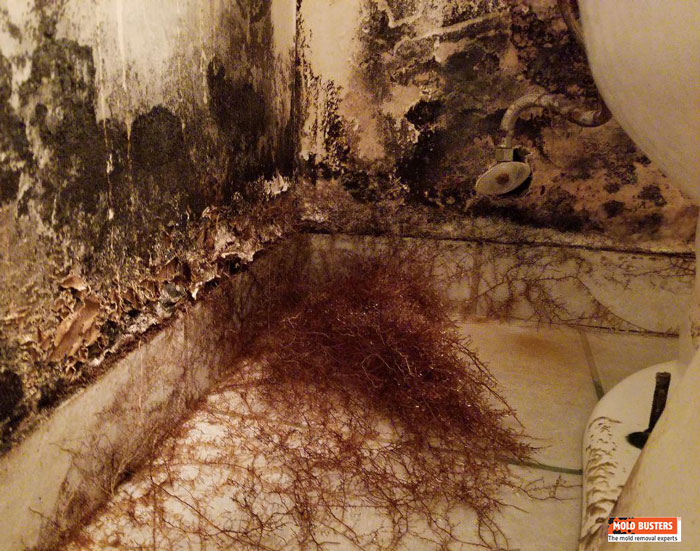
On the other hand, white mold is a powdery, stringy, flakey, or filmy substance that can change colour or remain white, making it difficult to identify. Generally speaking, white molds present less health risks than black mold.
How to differentiate between white mold and efflorescence?
White mold and efflorescence look a lot alike. In fact, they’re so similar that people often mistake one for the other. Both are white in colour and found on walls and other building materials. Understanding what both substances are and how they form will help you to determine which one is making an appearance in your home.
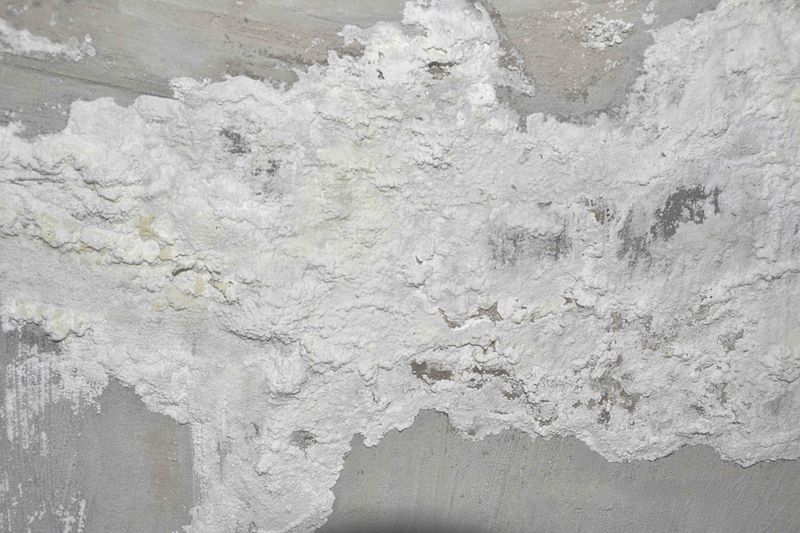
So what is efflorescence? Simply put, efflorescence is salt deposits commonly found on concrete and brick. It develops when water evaporates from concrete or brick, and leaves behind a salty residue on the surface of the material. However, efflorescence causes only cosmetic damage and will not threaten the structural safety of your home. Likewise it also doesn’t pose any risk to your health.
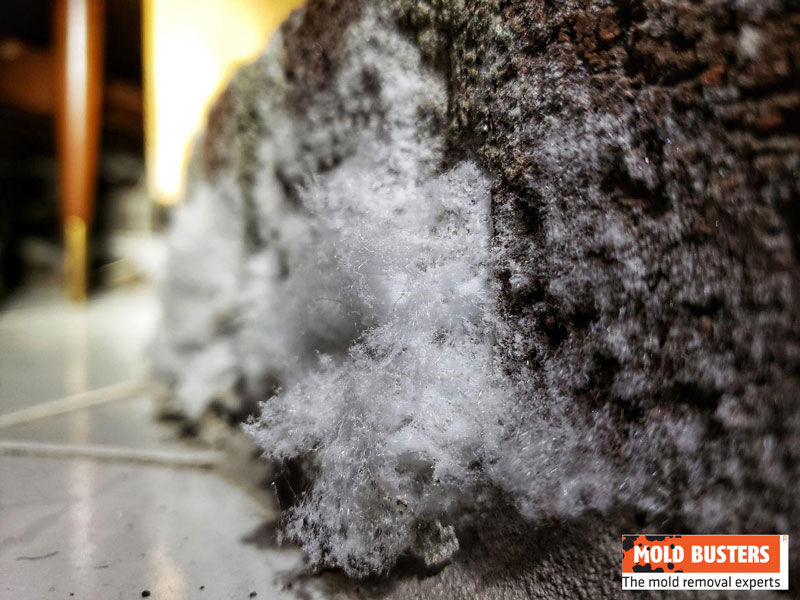
Tips for distinguishing between white mold and efflorescence:
- Efflorescence dissolves in water–mold does not
- Efflorescence is typically found on concrete and brick while mold grows on organic materials like wood and drywall
- White mold is a living organism (fungus) while efflorescence is simply salt deposits
- Efflorescence is not harmful. It won’t make you sick, but white mold will.
- White mold gives off a distinctive odour while efflorescence not.
What is white fuzzy mold?
This is a type of mold with a white, fuzzy appearance caused by the airborne spores of the fungus. The mold is also known as powdery mildew due to its powdery look and texture.
White fuzzy mold usually affects established plants and vegetation. Even in some cases, it can cover the entire plant, including its buds and fruits. It can also spread over the stems and leaves of indoor and outdoor houseplants.
Other common locations that boost the growth of white fuzzy mold include furniture surface areas, clothing and textiles, foods, crawlspaces, and attic sheathing and framing. Allowing this mold to spread in your home can stimulate allergic reactions in emotional people.
White mold species
Mold species that mostly appear white and have a powdery texture are described as white mold. The most popular of these species found growing in homes include Aspergillus, Penicillium, and Cladosporium.
White is one of the colors that these mold species appear; they also appear in other colors such as green, black, or gray. So, you can’t possibly determine the exact mold type based on the color. You’ll need mold testing to ascertain the specific type of mold growing on your property.

Did you know?
Penicillium / Aspergillus group is the most common toxic mold type found in homes we tested?! Find out more exciting mold stats and facts inside our mold statistics page.
Aspergillus
Aspergillus is a genus composed of 100 different mold species from all different climates. Aspergillus usually has a wool or cotton texture. Its varieties include Aspergillus fumigatus, Aspergillus flavus, and Aspergillus niger. These mold varieties vary from blue-green hues to yellow-green colors.
Aspergillus mold genus commonly produces allergic reactions. Its effects can lead to more serious health problems such as Aspergillosis (a type of lung disease).
Penicillium
Penicillium usually appears in white and, other times, in pink or yellow hues and has a powdery texture. Its stale odor can identify it. Penicillium can cause several allergies, including lung inflammation and hay fever. They can be used in cheese production and are famous for being the main ingredient in penicillin-based antibiotics.
Cladosporium
Cladosporium appears olive-gray and has a velvet texture. It causes allergic responses, particularly in infants. It also causes infections in the eyes, toenails, and fingernails. They can be found indoors and outdoors–most commonly on living or dead plant materials.
What causes white mold?
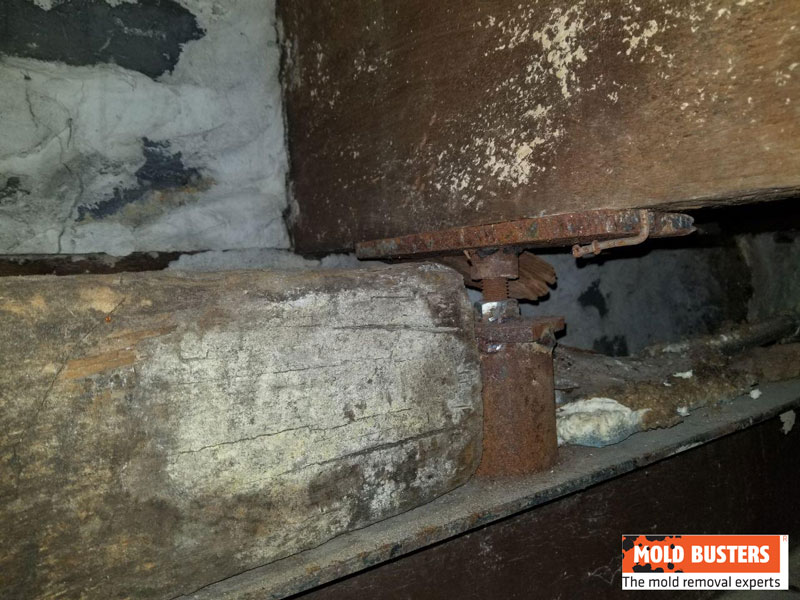
Like other molds, white mold grows due to high moisture levels combined with the presence of a food source, and the right temperature. Common food sources for white mold include wood, drywall, carpeting, laminate, insulation and any other organic, carbon-rich material.
The best temperatures in which mold grows is between 2 and 40 degrees Celsius.
As white mold spreads, it eats away at the material it is growing on. If this happens to be drywall or wooden beams, white mold can lead to both cosmetic and structural damage of your home.
Where can you find white mold in your house?
White mold can grow practically anywhere in your home, as long as the three conditions listed above (moisture, food source, temperature) are met. That said, some areas of your home are more likely to foster mold growth than others.
Here are the seven of the most common places we find white mold growing in homes:
White mold in basements
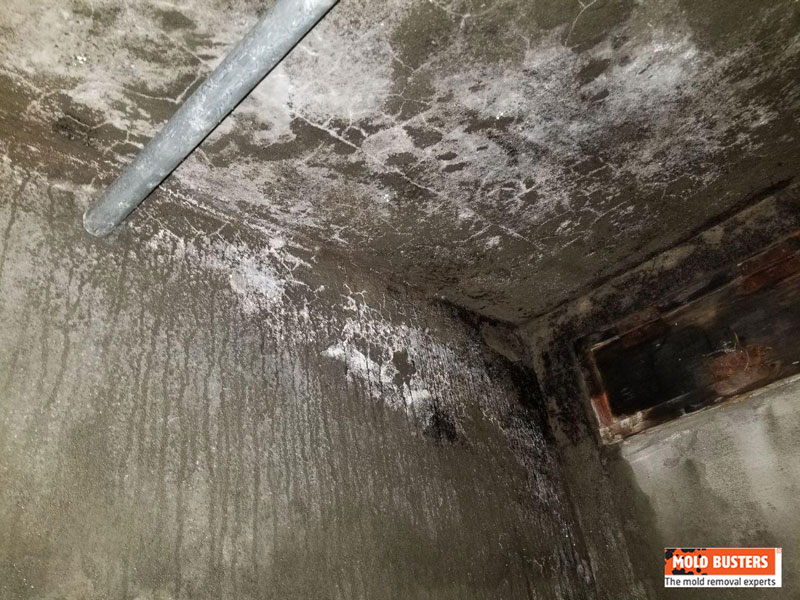
Have you ever noticed that your basement tends to be cooler than any other room in your house? While this can provide much needed comfort in the hot summer months, it can also be promoting mold growth. Here’s how. When warm outside air comes into contact with the cold basement walls, it condenses, creating moisture droplets on the walls. If this moisture isn’t dried promptly, mold will soon start to grow on your basement walls.
Dampness from the soil outside can also bring in extra moisture to the basement, creating a wet and humid environment perfect for mold growth. And because basements often lack proper ventilation (and are prone to flooding), they make a great breeding ground for white mold.
Ways to tell if you have a mold in your basement are a earthy or musty smell, condensation on the walls, bubbling paint or wallpaper, and discoloration on walls, ceilings, carpets, or furniture. If you notice something that looks like efflorescence, examine it closely and remember the tips we gave you on distinguishing between white mold and efflorescence. White mold will look white, cottony, flakey, and stringy and grows on organic materials.
White mold in attics
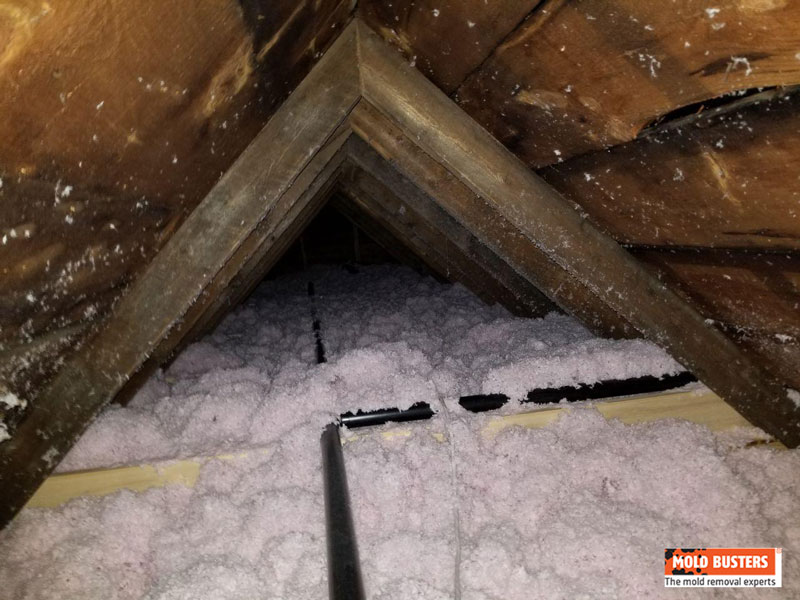
Attics contain plenty of food sources for mold including wood and insulation. As such, roof leaks from rainfall or melting snow, condensation resulting from temperature fluctuations, and/or leaky pipes can give mold the moisture it needs to thrive in attics.
White mold in crawl spaces
Crawl spaces are typically very tight spaces that are difficult to dry once moisture makes its way inside. Several reasons why mold tends to grow in crawl spaces are leaking pipes and plumbing, high humidity due to poor ventilation, and foundation cracks that allow water and moisture to enter. For all these reasons, many people question the practicality and necessity of crawl spaces.
White mold on carpets
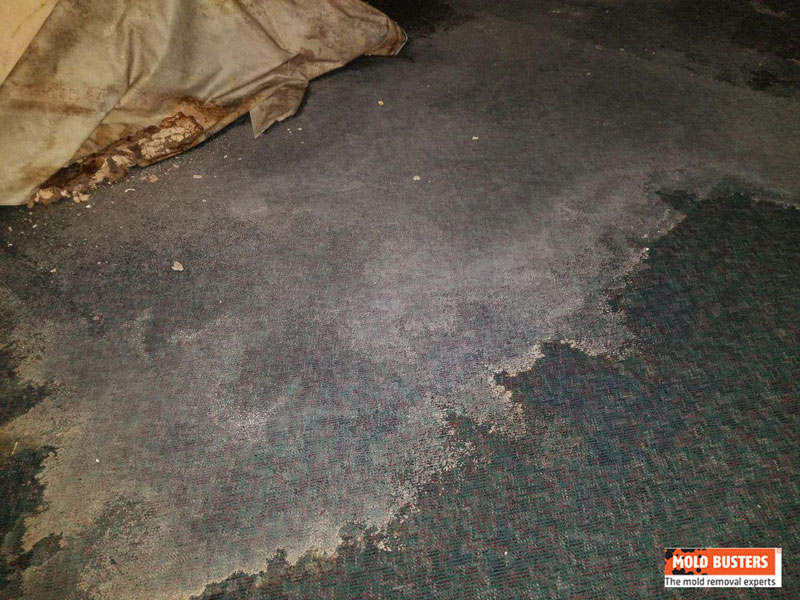
As most of us know, wet carpets are very difficult to dry, especially when we’re talking not just about a small spill, but a large leak or flood. This is when bacteria and mold have the opportunity to thrive. It is important to avoid carpeting your home below ground level or in rooms that are prone to spills, high humidity, and flooding (e.g. basements, kitchens, bathrooms and laundry rooms). Luckily, moldy carpets are fairly easy to recognize as they will give off a strong musty odor and cause allergic reactions. Try to clean and dry wet carpets promptly in order to avoid mold spreading to the subfloor. If this happens, you will likely have to remove and replace your entire flooring system.
White mold on wood
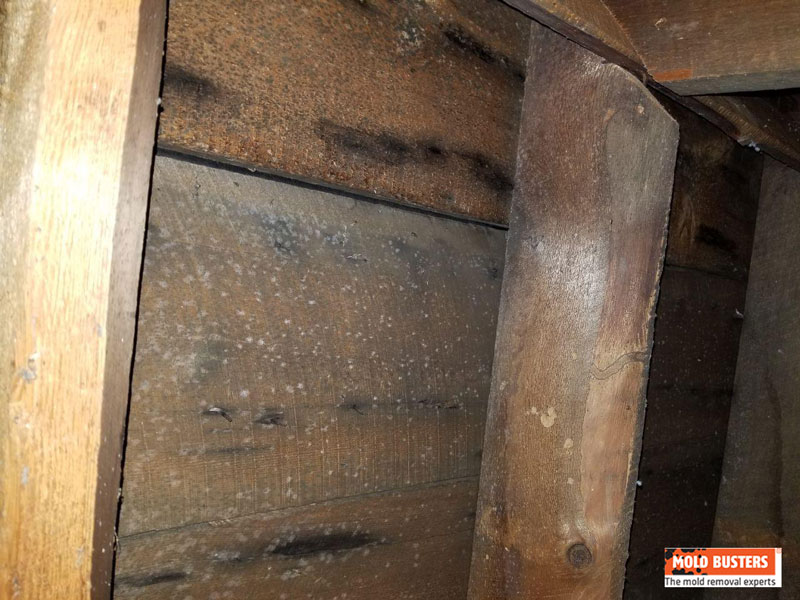
Unfortunately, white mold loves wood, which means that your hardwood floors, furniture, cupboards and structural components of your home (beams, joists, etc.) are at risk. If you’ve had a recent moisture intrusion, keep an eye out for the most common sign of white mold on wood: discoloration in the form of white spots or blotches.
White mold on plants and plant soil
White mold that grows on plants or vegetation is referred to as Sclerotinia. Because mold spores can become airborne easily, it is important to control the problem right away.
There are several signs of mold growing on plants. Water-stained spots will appear at the root even though the remaining part of the plant will look healthy. The plant may be wilting and discolored at the root. Or, there may be brown lesions on the plant and, from these lesions, a dense white cottony patch will form.
White mold can also appear on and spread through plant soil. Overwatering a plant, poor drainage, and old soil can promote mold growth. The best mold prevention for plants is not to overwater them, to remove weeds that carry diseases, to use fresh soil, and if possible to remove all crop residue after harvesting. Mold spores survive winter conditions so it is best to deal with the problem as soon as you see it.
White mold in your car
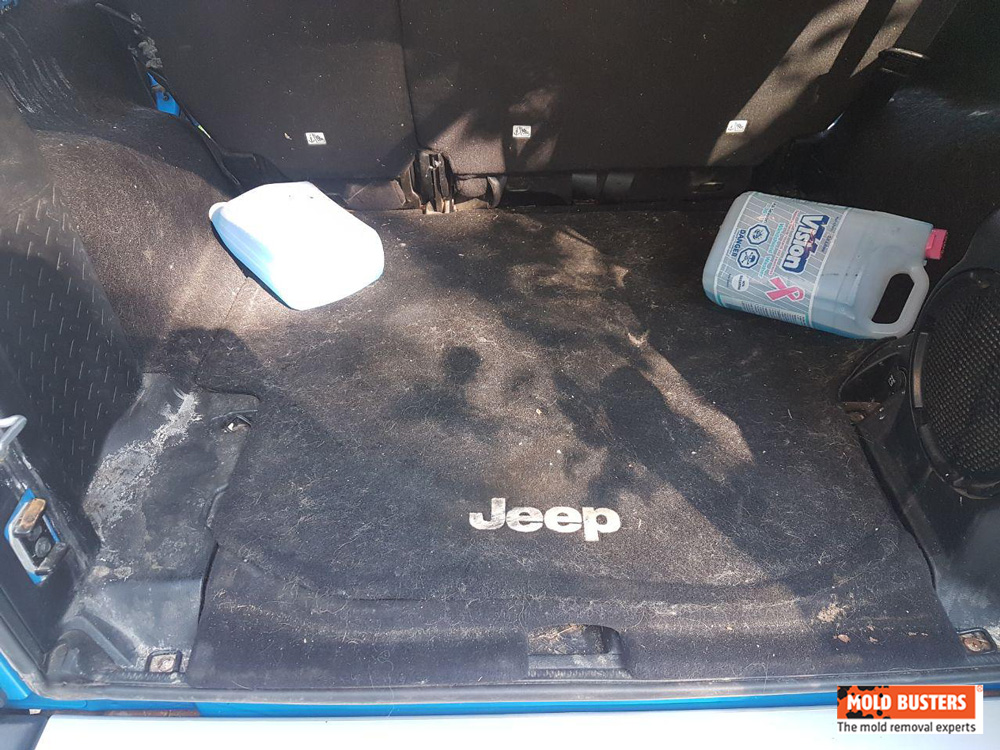
Even though your car isn’t technically your home, it is still one of the more common places we have found white mold. The truth is that moisture can easily make its way into your car, whether through the air conditioner, a poorly sealed window, door or sunroof, a spill, or simply an open window. Once mold has started growing inside your car, it can quickly spread onto upholstery, carpeting, and seats–ultimately destroying your vehicle. And if mold has gotten inside your car’s air conditioner, it will circulate through the air and expose you to potentially toxic mold spores. The best indication that your car has mold is white spots or an earthy odour.
White mold on walls/drywall
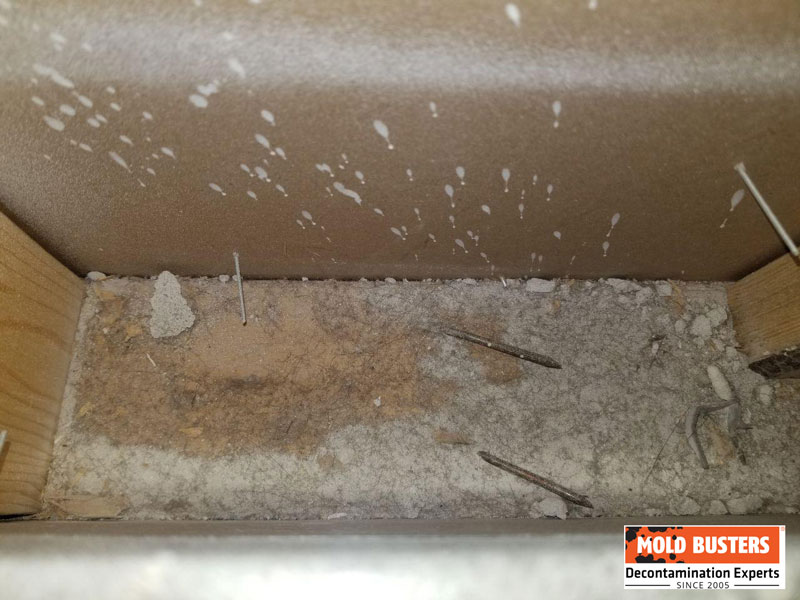
White mold grows on your walls or drywall in the presence of moisture and low lights that breed its food. It can develop anywhere on your building walls, including the basement, bathrooms, laundry rooms, kitchens, and other poorly ventilated rooms. Surprisingly, you can also find white mold growing on your tiled walls.
You can see visible growth of this mold on your damp painted or wallpapered walls that are peeling. Accompany signs include stale smells, moist cracked paints, and dusty or swollen walls.
White mold growth on your drywall can be dangerous to the health of those with allergy symptoms. Its spores can spread from the walls to humans and cause health risks. So, before it strikes, act fast to strike it first.
White mold on concrete
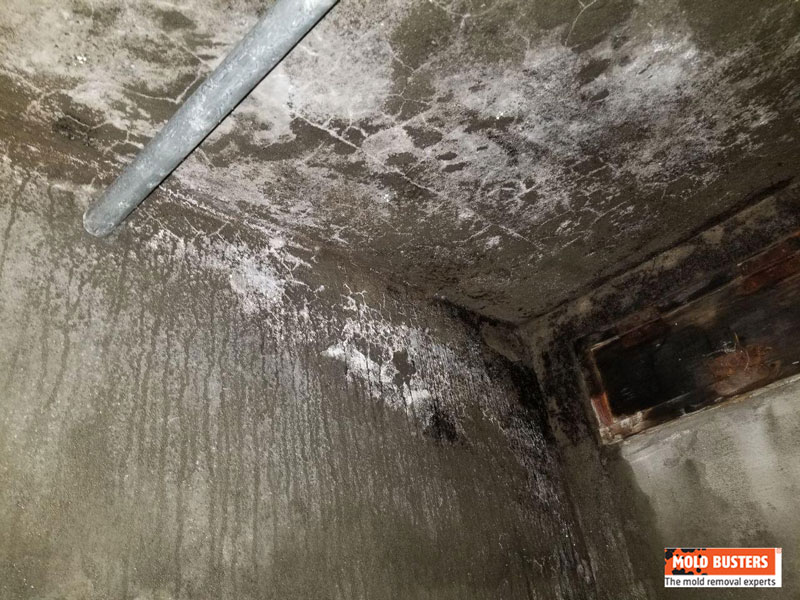
Mold grows everywhere, but has anyone ever thought it could grow on concrete? Yes, it does! Mold is commonly found on concrete basement floors. Typically, you’ll see a fuzzy, white mold growing on the surface of your concrete due to moisture rising from the wet ground.
Most times, the mold grows after prolonged dampness or flooding. You can easily identify it by its characteristic white cottony mycelium.
White mold on concrete can cause health issues, including infections, asthma, and other respiratory problems. You should prevent mold from growing on your concrete but when found, remove it as soon as possible.
White mold on furniture
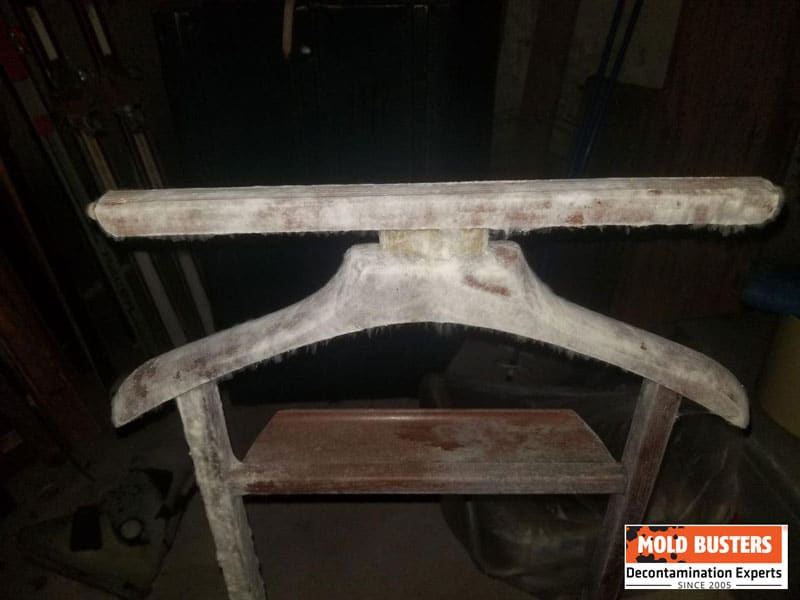
In moist conditions, white mold can grow on wood, upholstered, and leather furniture. Over time, the mold fungus can lower the furniture’s value and make it give off an awful, musty smell. However, you should detect the factors stimulating this growth so you can protect your family against dangerous allergens.
First, it could be due to the furniture being enclosed, damp storage for a long time before taking it out. But if a piece of furniture suddenly starts to grow white mold, examine the surrounding areas that may likely introduce moisture to the furniture.
When floorboards, windows, and ceilings have cracks and leaks, they can turn furniture humid. These thus encourage white mold to start growing on the piece of furniture.
White mold on cabinets
Are your cabinets safe from white mold? In addition to white mold causing health issues, your cabinets are also prone to destruction. White mold is sometimes hidden in the cabinet under your sink until it has caused a severe problem. But how would you know if white mold is on your cabinets?
You may see discolorations in the damp areas of your cabinets, which may also give off a stale, moldy smell. One of the causes is a leaking pipe that may trigger moisture beneath the sink. The cabinet can also become moldy through poor cleaning and when old foods are left out.
White mold on metal
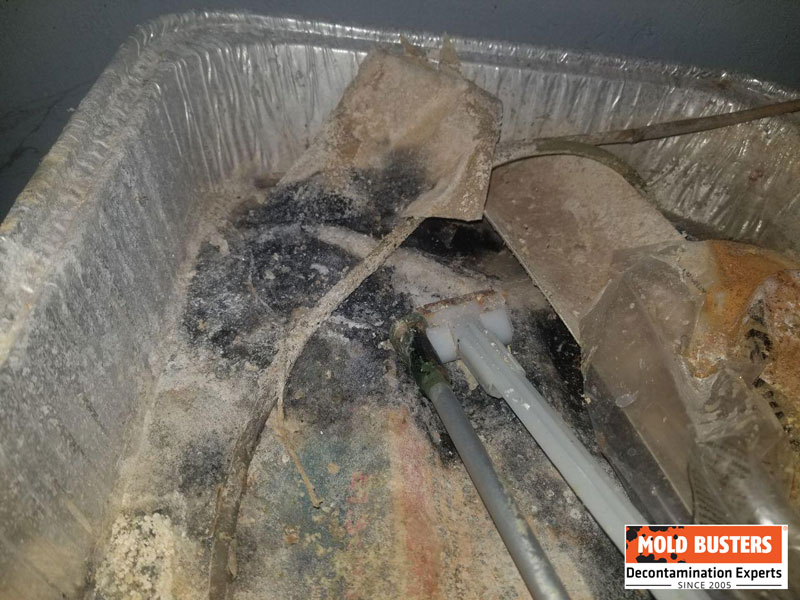
Anyone could ask, “can white mold grow on metal?” Due to the non-porous surfaces of metal, mold will not grow directly on it. The build-up of food spills and other mineral debris on such surfaces can encourage mold growth. Improper ventilation, humidity, and moisture contribute to the growth of this fungus on metals, such as steel.
Under favorable conditions, both indoor and outdoor metal materials are susceptible to white mold growth. Ignoring this fungus on your steel, copper, aluminum, and other metal structures can shoot up white mold spores to other surrounding materials like wood and drywall. It is therefore recommended that you cub the spread before things get out of hand.
White mold in bathroom
White mold in your bathroom can be unsightly, bringing in health risks to homeowners. Not sure whether white mold is in your bathroom? Check your ceiling; the painted or wallpapered walls, caulk, and tile grout. These are the most common places where you can find mold fungus developing in your bathroom.
The bathroom has the perfect humid and temperature conditions for mold growth. Leaky plumbing pipes, sinks, and toilets can encourage fungus growth. Also, the absence of ventilation can cause lingering moisture. Considering the well-being of your household, you need to get rid of the white mold fungi as soon as you spot them.
White mold in garage
The garage is often dark and humid because it doesn’t get much sunlight when the door is down. Moisture builds up with musty odors filling the air. And before you know it, you already have mold in the garage.
The fuzzy white texture on your garage walls, ceiling, or concrete shows the likeness of white mold growing in the space. Because your garage is often overlooked, white mold in this area of your home can be dangerous.
If you don’t always check around your garage, the mold odors mighty increase rapidly. The spread of mold spores can damage the affected areas and cost you a lot of money in the long run. Besides, it can also lead to diverse health issues such as asthma.
White mold on tiles
Wondering how white mold finds its way to the tiles in your bathroom walls, hallways, and kitchen floors? This is no longer a surprise as the tiles in these spaces are surrounded by conditions favorable to mold. An increase in room temperature usually causes moisture and humidity that white mold thrives in.
Food and drink spillages on ceramic walls and floor tiles could breed mold. The grout between the tiles can also harbor white mold, making the mold spores spread to other areas in the room. Mold fungus on tiles may be hideous and dangerous to life and property. As such, it’s essential you ask for professional help in the eradication process.
White mold on clothing and other materials
White mold is not limited to growing on building materials and hard surfaces; it can also infest clothing and other organic materials. This is particularly common in environments with high humidity or excess moisture.
Clothing stored in damp, poorly ventilated areas is especially susceptible to white mold growth. This can include closets in basements or bathrooms, or clothes left in a damp pile for an extended period. White mold on clothing can appear as a fuzzy white substance, often causing discoloration and a musty odor.
In addition to clothing, white mold can also grow on other organic materials in your home. This includes furniture, carpets, and even books. These items provide a food source for the mold, and when combined with a moist environment, can lead to significant mold growth.
It’s important to note that white mold can penetrate deep into porous materials, making it difficult to remove completely. Simply cleaning the surface may not be enough; in some cases, the affected items may need to be discarded to prevent the mold from spreading.
Preventing white mold on clothing and other materials involves controlling the moisture levels in your home. This can be achieved through effective air conditioning, dehumidifiers, and good ventilation. Additionally, avoid leaving wet clothes in a pile and ensure that items are completely dry before storing them.
If you discover white mold on your clothing or other materials in your home, it’s important to handle the situation promptly. Small amounts of mold can often be treated at home, but for larger infestations or if the mold has penetrated deep into the material, you may need to seek professional help. We offer a virtual inspection service that can help you assess the situation without the need for an in-person visit.
White mold under floorboards
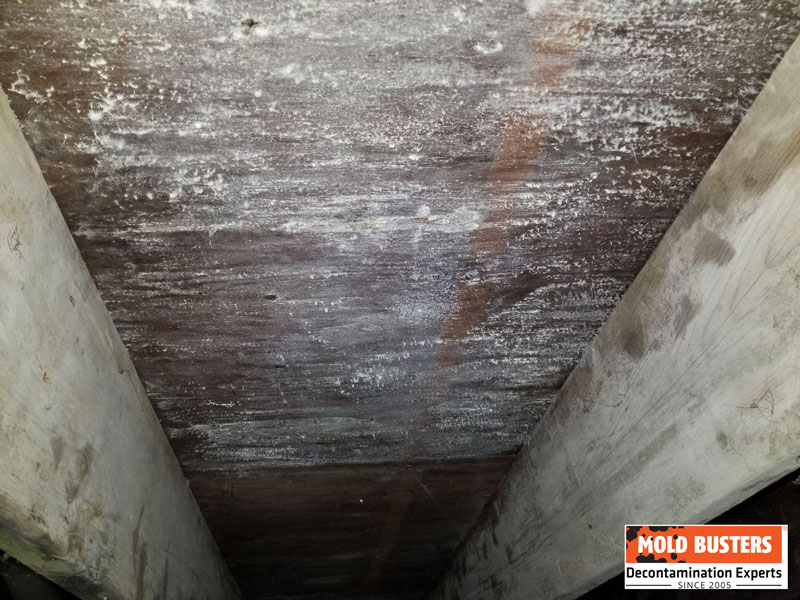
Have you ever perceived a musty odor somewhere around your home floorboards? That’s a sign that your wooden floor is growing mold under perfect conditions. Several mold testing results reveal that the most commonly found fungus under the floorboards is white mold.
It’s not strange that white mold can grow under floorboards. It can be tricky in its early wwws of development and become unsightly under your flooring for quite some time. Over time, the smell will aggravate and make residents start sneezing and coughing.
You need immediate mold remediation to keep your floorboards from damaging and protect the lives of your family.
Is white mold dangerous?
While mildew and similar types of mold are less of a danger and more of a hindrance, white mold is a health hazard. Inhalation of white mold spores, especially over a long period of time, can cause mold-induced asthma, allergic fungal sinusitis, allergic bronchopulmonary aspergillosis (danger for those with asthma or cystic fibrosis), and hypersensitivity pneumonitis.
Let’s look at the health effect of mold in greater detail:
- Allergenic molds cause allergies as well as asthma. When you come into contact with these types of molds, your respiratory system flares up. Around 20-30 % of individuals have a allergic reaction to mold that can lead to rhinitis, otherwise known as hay fever. Minor reactions are congestion, rash, and itchy eyes to very severe reactions of swelling, difficulty breathing vomiting, diarrhea, vomiting, and mental confusion.
- Pathogenic molds are able to cause more serious diseases. For people that have weak immune systems, these types of molds can severely affect the person’s already compromised health. Minor reactions are skin irritation, nail infections, and athlete’s foot while severe reactions are life-threatening infections of organs.
- Toxigenic molds release substances called mycotoxins, which are extremely harmful to humans. Pathways of exposure to these molds include ingestion, inhalation and direct contact (touch). Depending on the individual, the duration of exposure, and the pathway of exposure, reactions to toxic molds can range from irritation to lifelong illness. Some of these deadly illnesses are hormone disorders, liver damage, nervous system disorders, and cancer.
Most white molds tend to be allergenic or pathogenic. However, regardless of the type of mold you find growing in your home, you should always consult qualified professionals about how to remove the mold toxin from your home safely and effectively.
How to identify white mold?
Most of the time, you can identify white mold by examining its colour, texture, and odour. If it is fluffy, white, slimy and carries a specific musty odour, it’s likely white mold. Meanwhile, black or olive green discoloration will most likely be black mold.
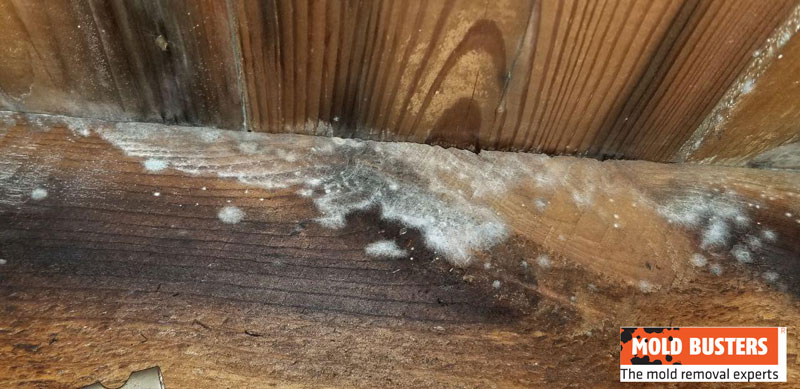
However, mold doesn’t always grow in plain sight, which is why it is important to get your home tested for mold as soon as you suspect a problem.
How to remove white mold?
While some types of mold and mildew are easy to remove with household products like vinegar, white mold is much more difficult (and dangerous) to remove on your own. It may have penetrated deep below the surface of the contaminated material or it may be growing in places you aren’t even aware of.
Furthermore, do-it-yourself mold removal always puts you at risk of spreading the contamination and exposing yourself to toxic mold, which can lead to serious health effects. Furthermore, most people do not possess the equipment or know-how to remove toxic mold safely and effectively.
Whatever you do, don’t let mold grow in your house for a long time. Contact a certified mold removal expert to explore all remediation strategies and help you pick the one that’s best for you.
Tackle White Mold with Our DIY Remediation Kit!
Worried about white mold in your home? Our DIY Mold Remediation Kit has everything you need to safely and effectively remove mold. The kit includes protective gear, eco-friendly cleaning products, and an easy-to-follow manual.
Conclusion
Due to its changing appearance and tendency to grow in areas of high moisture (much like black mold), white mold is not the easiest to recognize unless you are a trained and experienced mold professional. Furthermore, properly identifying white mold is only part of the problem. The other part includes finding the moisture problem that’s causing the mold growth and cleaning up the contamination effectively. For this, it is always better to rely on a reputable mold remediation company.
FAQ
What’s the difference between white mold and black mold?
Both white mold and black mold can cause health issues. The main difference is their color and the types of materials they prefer to grow on. White mold is often found on hard surfaces and building materials, while black mold prefers damp, warm conditions.
What is mold remediation?
Mold remediation involves removing existing mold, fixing the moisture problem causing the mold growth, and taking steps to prevent future mold growth. This process often requires a mold professional.
What should I do if I find mold in my house?
If you discover a mold problem in your house, it’s important to address it immediately. Small areas of surface mold may be cleaned using a baking soda solution, but for larger infestations or if the mold is growing on porous materials, it’s best to call a mold professional for mold inspection and remediation.
Can air conditioning affect mold growth?
Yes, air conditioning can help control the level of moisture in your house, reducing the likelihood of mold growth. However, if not properly maintained, air conditioning units can themselves become sites of mold growth.

Get Special Gift: Industry-Standard Mold Removal Guidelines
Download the industry-standard guidelines that Mold Busters use in their own mold removal services, including news, tips and special offers:
Published: January 16, 2019 Updated: May 22, 2024

Written by:
John Ward
Account Executive
Mold Busters
Fact checked by:
Michael Golubev
CEO
Mold Busters

